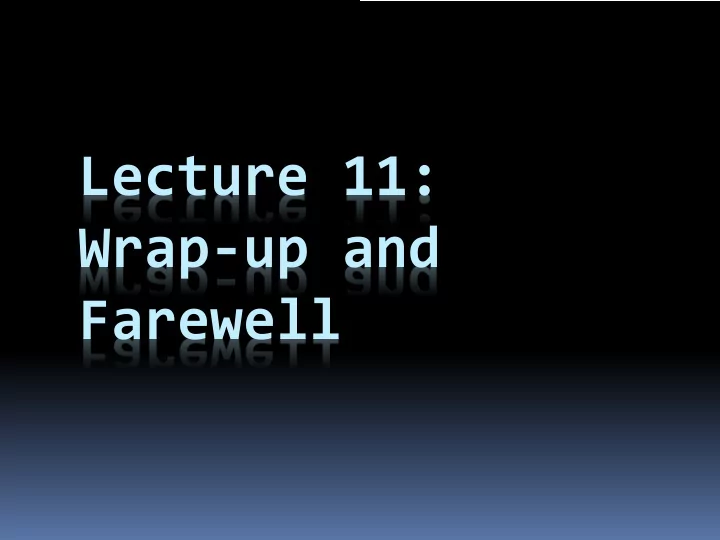

Lecture 11: Wrap-up and Farewell
We’re Almost Done § We’ve covered ú Arithmetic and logical operations ú Branches for loops and conditions ú Memory ú Functions ú Stack ú Calling conventions
Talking To Hardware
Input and Output § There is a world outside the CPU ú VGA ú Hard drives ú Keyboard, mouse ú Network cards ú etc. § How do we communicate with this hardware? § How do we do I/O (Input/Output)?
Memory Mapped I/O § Certain memory addressed don’t go to RAM. CPU § Instead, they go to device registers. ú Write to control a device. ú Read to get data or device status. RAM VGA § Often works with polling: ú Example: to know if an operation is finished, we read memory in a Keyboard loop until status is “finished”.
Interrupts § Rather than polling, devices can interrupt the processor to signal important status ú Operation completed, error, and so on. § Interrupts are special signals that go from devices to the CPU. § When an interrupt occurs, the CPU stops what it is doing and jumps to an interrupt handler routine ú This routine handles the interrupt and returns to the original code.
Handling Interrupts § Polled handling (not related to previous polling): ú CPU branches to generic handler code for all exceptions. ú Handler checks the cause of the exception and branches to specific code depending on the type of exception. ú This is what MIPS uses. § Vectored handling: ú We first assign a unique id (number) for each device and interrupt/exception type (example from 0 to 255). ú We set up a table containing the address of the specific interrupt handler for every possible id. ú On interrupt with type X, the CPU gets the address from row X of the table and branches to the address. ú This is what x86 uses.
Exceptions § An exception is like an interrupt that comes from inside the CPU. ú The mechanism is similar, the difference is semantic. § Reasons for interrupts/exceptions: ú Device I/O (interrupt) ú Invalid instruction (can’t decode!) ú Arithmetic overflow ( add with overflow). exceptions ú Divide by zero. ú System calls (also called traps)
MIPS Interrupt Handling § MIPS has polled interrupt handling: the processor jumps to exception handler code, based on the value in the cause register (see table). § If the original program 0 (INT) external interrupt. can resume afterwards, 4 (ADDRL) address error exception (load or fetch) this interrupt handler 5 (ADDRS) address error exception (store). returns to program by 6 (IBUS) bus error on instruction fetch. calling rfe instruction. 7 (DBUS) bus error on data fetch 8 (Syscall) Syscall exception § Alternatively, the OS 9 (BKPT) Breakpoint exception terminates the program. 10 (RI) Reserved Instruction exception ú For example, dump the 12 (OVF) Arithmetic overflow exception contents of the stack to disk or screen to help debugging.
Coordination § Talking with hardware is a lot of work. ú What if you change your hardware, do you need to change every program? ú Should we duplicate code (e.g., for handling keyboard) in every program that needs it? § Who will manage all the different programs on the computer and offer them I/O services? § We need some sort of master control program to coordinate all this...
The Operating System
The Operating System § The operating system is the program that manages all the other programs. ú Loading, running, and stopping programs. ú Running multiple programs simultaneously. ú It abstracts hardware and I/O, and offers services. § Programs invoke the OS to do things like: Learn more ú Read/write from files. ú Write to screen. in C69 ú Run other programs § Invoking the OS is done via system calls or traps.
Trap Instruction Function Syntax SPIM Service Input/Output Code 001100 syscall I print_int 1 $a0 is int to print (R-type) $a0 is address of ASCIIZ string print_string 4 § Trap instructions send to print read_int 5 system calls to the $v0 is int read operating system $a0 is address of buffer read_string 8 $a1 is buffer size in bytes ú e.g. interacting with the exit 10 user, and exiting the $a0 is address of ASCIIZ string program. containing file name open_file 13 $a1 is flag ú Trap code goes in $v0 $a2 is mode § These are services $v0 is file descriptor offered by SPIM. $a0 is file descriptor $a1 is address of input buffer read_from_file 14 $a2 is number of characters to read $a0 is file descriptor $a1 is address of output buffer write_to_file 15 $a2 is number of characters to write close_file 16 $a0 is file descriptor
Example .data var1: .word 10 str1: .ascii "Hello World" .text main: li $v0, 1 # print the number stored in var1 la $t0, var1 lw $a0, 0($t0) syscall li $v0, 4 # print the string stored in str1 la $a0, str1 syscall end: li $v0, 10 # exit the running program syscall
One More Thing § Calling future TAs! ú Want to TA B58? ú Looking for Verilog experience (small candidate pool) ú You can help improve/shape the future of the course. ú Ask your current TAs what they think! § Course Evaluations ú They are anonymous. ú I do actually read them. ú I do actually care. ú They do actually make an impact. ú No, I won’t bribe you
Cake Courtesy of Sophie Harrington
WE ARE DONE! Assembly Language Processors Arithmetic Finite State Logic Units Machines Devices Flip-flops Circuits Gates Transistors
Given enough silicon, phosphorus and boron, you are now able to build a computer!
Good luck!
Recommend
More recommend